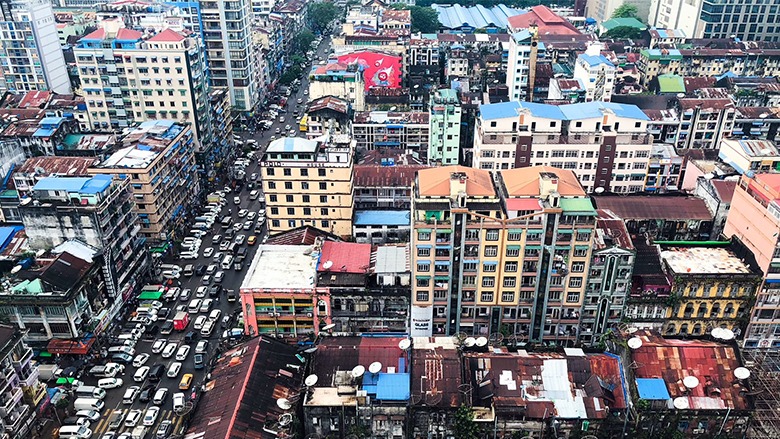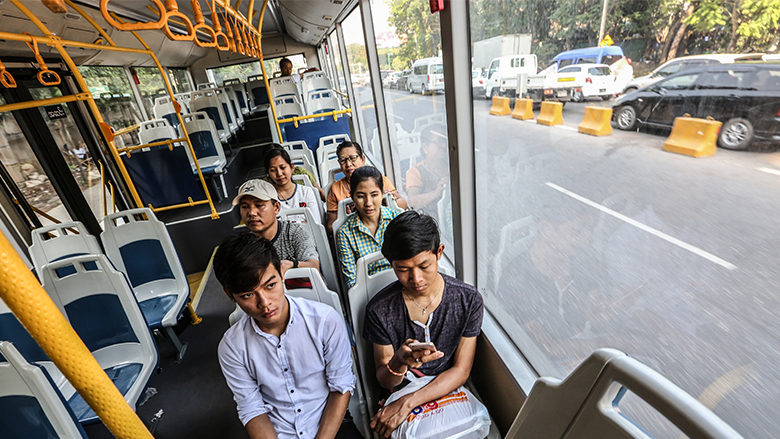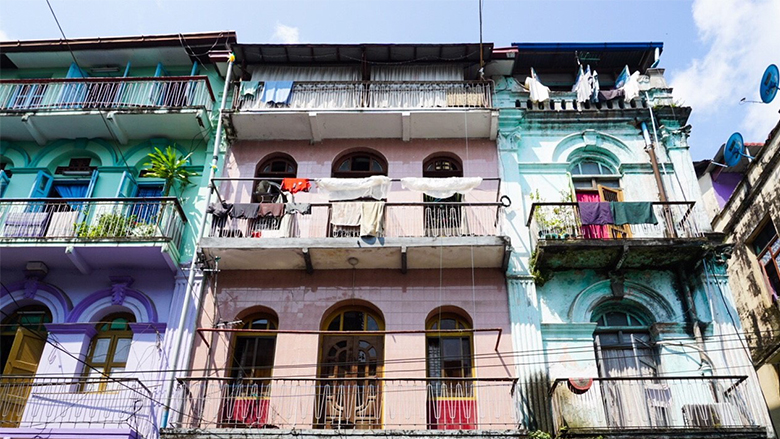Myanmar is still in an early phase of urbanization. This brings many opportunities to shape cities for sustainable growth and poverty reduction. An inclusive approach will help to ensure that cities grow in an equitable way that will bring significant benefits for peace and stability. A new report entitled Myanmar’s Urbanization: Creating Opportunities for All identifies key challenges and provides policy recommendations for urbanization in Myanmar, with a special focus on Yangon and Mandalay.


How is urbanization changing Myanmar?
Myanmar has seen a rapid transformation over the past several years rooted in economic and political reforms which have created opportunities for many. This has been accompanied by growth and poverty reduction, with GDP growing by over 8 percent per year on average between 2005 and 2014, and poverty decreasing from 48 percent to 32 percent during the same period. Much of the growth is happening in cities, driven by an expansion in construction, services, and manufacturing. This has resulted in a faster increase in private expenditures, and a sharper decline in poverty in percentage point terms relative to rural areas. Approximately 30 percent of Myanmar’s population are now living in urban areas.
What are some key findings and challenges for urbanization in Myanmar?
While urbanization often brings immense opportunity for urban dwellers, keeping pace with the growing needs of citizens in cities often presents a challenge. Inadequate planning and a lack of investments in infrastructure and the provision of basic services can lead to sprawl, environmental pollution, congestion and inequality. Overtime, inequality can undermine the benefits that urbanization typically brings as it can create or worsen social divisions and contribute to rising crime and violence in cities. This accentuates the urgent need to focus attention on investing equitably in urban development.
- Urbanization in Myanmar is steadily on the rise with notable reductions in poverty
Myanmar remains a predominantly rural country, with 15 million of the country’s 51.5 million people living in urban areas. However, this figure is expected to change -- projections indicate that an additional 7.1 million of its current rural population will move to cities by 2050. The increase in urban population has begun to put a severe strain on cities, particularly Yangon, and the needs for affordable housing, infrastructure and services. In Yangon, for example, only 33 percent of the city’s population have access to piped water, traffic congestion is on the rise, as is solid waste, flooding and pollution. There is also a rise in the number of informal settlements as new residents cannot afford the existing supply of housing. If left unaddressed, these infrastructure needs will lead to further congestion, slums, pollution, and put a drag on opportunities for growth. - Cities are centers of economic growth, but not everyone benefits
Cities are centers of economic activity and job creation, but for some, there are barriers in accessing income earning opportunities given issues linked to the labor market that result in high informality, low skills, or discrimination. Some key constraints affecting vulnerable groups – such as ethnic minorities, migrants, the urban poor, women and the disabled – include: lack of skills, high informality, discrimination in the labor market, and high risk to natural hazards, economic and health shocks. - Challenges in the delivery of affordable housing, basic infrastructure and services particularly affect the urban poor and result in disparities in living conditions
Vulnerable groups and minorities in Myanmar face challenges of spatial exclusion related to accessing urban land markets, housing, and basic services in large part due to where they live or their citizenship status. The report identifies challenges related to spatial inclusion such as:- Spatial planning is limited and hampered by capacity constraints
- Urban land administration is complex and results in high costs for land
- Access to affordable housing is very limited leading to growing informal settlements
- Infrastructure and basic service needs in urban areas are huge
- Urban mobility and transport are challenges for many
- Coverage for urban water and sanitation is low leading to health risks
- Solid waste management services are limited, particularly in slums, and create urgent challenges
- Disaster Risk Management is exacerbated by poor drainage creating substantial flood risk during the monsoon season
- Inequitable opportunities affect many
Social inclusion relates to fostering and enabling inclusive attitudes towards marginalized groups, regardless of differences in gender, ethnicity or region of origin. In Myanmar, a few subgroups are vulnerable to exclusion in the urban context -- internal migrants, the urban poor, people with disabilities, and some ethnic and religious minorities. - Governance and financing for urban development is challenged in fulfilling key roles
While urban service delivery functions have been devolved to subnational governments, in practice, local governance is often hampered due to limited implementation of policies/frameworks, financial resources, and technical capacities. Lack of transparency and fair decision making as well as insufficient resources to successfully implement programs and policies on the ground may lead to unequitable urban development and intra-city disparities, which may further lead to social tensions, crime and violence.

What policy recommendations does the report provide?
Myanmar’s Urbanization: Creating Opportunities for All provides an inclusive urbanization framework that includes three key dimensions; economic, social and spatial. The three dimensions of inclusion are highly interlinked, and any approach to understand the complexity of issues or develop solutions must consider all three.
For example, challenges in accessing income earning opportunities may be linked to macro level problems in the economy and structural problems in the labor market, but also may be linked to where people live and the possibilities for affordable transport to jobs and markets, limited basic infrastructure for home-based work, and/or exclusionary policies or social practices for some groups that are discriminatory. In the case of urban areas in Myanmar, marginalized groups are identified as the urban poor, migrants, non-Bamar ethnic groups, religious minorities, women and the disabled, who face exclusion from jobs, housing, and infrastructure and social services for various reasons.
The framework of economic, spatial and social inclusion used in the report points to several priority policy recommendations, outlined in the table below including indication of short, medium and longer-term prioritization. Many of the recommendations come back to the need for:
- investments in sustainable urban infrastructure and in-situ community based urban upgrading to provide basic services for all, ensure mobility for the flow of people, goods and services;
- building resilience to mitigate the impact of shocks on people’s livelihoods and health;
- reforms to policies to facilitate access to legal documentation for migrants and specific subgroups, and targeted social programs for those that are particularly vulnerable to exclusion and may not be able to benefit from urban opportunities; and
- capacity building and new financing for urban development
Taking these recommendations forward will require additional work to identify champions, key stakeholders, find relevant entry points for private sector investment, and ensure a stable governance framework aligned with sufficient technical capacity and financing for implementation. These are challenges that the World Bank and other development partners can support in partnership with the Government of Myanmar.